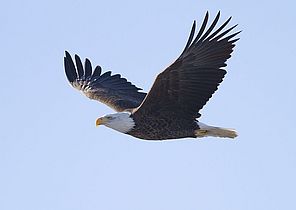The Return of the Eagle
March 2012
On a recent winter day my family was exploring some woodlands along the shore of a river near Lake Champlain. My daughter exclaimed about the huge birds in the trees on the opposite side. Three bald eagles sat regally staring out over the landscape. Bald eagles were once nearly unheard of in the skies of our region. Now, they are following in the path of osprey populations as their numbers steadily increase.
Bald eagle sightings in our area are most common during the winter and early spring. At that time birds from areas where the lakes and rivers have frozen congregate around open water where they can still fish. Later in the winter, birds from farther south begin their journey to northern breeding grounds and may spend some time on Lake Champlain. By the end of March, most bald eagles have returned to the territory they will occupy until the fall migration, although unmated birds roam widely during the summer in search of food.
Bald eagles population’s reached their nadir in the 1970s. An estimated 100,000 bald eagles resided in the continental United States when Europeans first arrived. Though the population decreased as a result of hunting and habitat loss, the decline was most dramatic between the 1950s and the 1970s. During that period the use of the pesticide DDT was at its highest. DDT worked its way up the food chain and in large birds slowed calcium metabolism leading to nest failures. By the early ‘60s fewer than 100 bald eagles were nesting in the northeastern United States, and they were placed on the federal endangered species list.
The population has since rebounded. DDT was banned and captive breeding programs re-introduced eagles to many areas where populations had crashed. Today there are approximately 10,000 breeding pairs of eagles in the lower 48 states. New York alone hosts over 200 breeding pairs of bald eagles. By contrast, one biologist estimated only 40 nesting pairs of eagles in New York at any one time between the 1800s and 1979. In 2010, 14 young eagles fledged in the Adirondack-Lake Champlain region. There are at least three known nests on the New York side of Lake Champlain. Vermont was the last state in the continental United States to successfully produce young eagles. The first confirmed Vermont fledging occurred in 2008 in the Northeast Kingdom. Last year, ten active nests in Vermont produced 13 eaglets; four of those nests were in the Champlain Valley. On July 9, 2007 eagles were removed from the federal endangered species list.
Good bald eagle habitat has three important components. The birds need an adequate supply of food, typically moderate-sized to large fish. They need large trees preferably less than 1/3 mile from the water. Finally, they need freedom from disturbance, so more remote areas are preferred. The Vermont Bald Eagle Recovery Plan (a Department of Fish and Wildlife report from which much of this information was gathered) has identified ten areas along Lake Champlain’s Vermont shoreline that could offer suitable nesting habitat for them.
Nest building takes place over a period of a few years. It is not unusual for a pair of eagles to unsuccessfully nest one year but then return in subsequent years until they get it right. They usually produce two eggs per clutch though sometimes three, and on rare occasions, four eggs. They incubate the eggs for a little over a month. Once hatched, young fledge after 10 to 12 weeks. Adults will continue to feed the young for quite a while after they have left the nest.
Bald eagles are one of eight living species in the genus Haliaeetus, and the only one of the eight to live in North America. (Our other North American eagle, the golden eagle, is in a different genus). The name Haliaeetus comes from the Greek: Halio meaning of the sea, and aetos meaning eagle. Sea eagles are sometimes called erns or ernes, a commonly occurring clue for crossword fans. They range in size from the giant Stellar’s sea eagle at almost 20 pounds to the much smaller Sanford’s fish eagle at four and a half to six pounds. Our bald eagle usually weighs about 14 pounds. All are adept at catching and feeding on fish, though they will take mammals or birds as well. The specific name for our bald eagle is H. leucocephalus also from Greek: leuco - white, and cephalus - head.
Young eagles do not sport the iconic white head and white tale of adults. Juvenile birds appear almost entirely black when perched. In flight, there is some mottled white on the wings and tail. In the second year, the birds have much more white in the body and wings and a white triangle develops between the shoulders in back. Juveniles actually sport broader wings and longer tails than adults. The pure white head and tail appears in the fourth or fifth year when the birds are ready to nest. The oldest recorded wild bald eagle was a 28-years old individual in Alaska.
Not all bald eagles are the same size. As in many raptors, females are larger than males. Northern birds also tend to be larger than birds from the south. At times, taxonomists have considered splitting the species into two subspecies based on the northern/southern size difference. Larger animals retain heat better than smaller animals, a fact which may explain both size discrepancies. Northern birds obviously have to deal with colder temperatures. Perhaps female birds also have to deal with colder temperatures as they spend more time on the nest. However both sexes do tend eggs, and there are a number of other hypotheses that might explain the larger female size.
Frequently, the stories we tell about the environment speak only of the destruction ecosystems face at human hands. The story of the bald eagle offers a bright contrast. If we address the causes of environmental decline, biological organisms and systems can sometimes recover from the devastation wreaked upon them. Nature truly is resilient.
Lake Look is a monthly natural history column produced by the Lake Champlain Committee (LCC). Formed in 1963, LCC is the only bi-state organization solely dedicated to protecting Lake Champlain’s health and accessibility. LCC uses science-based advocacy, education, and collaborative action to protect and restore water quality, safeguard natural habitats, foster stewardship, and ensure recreational access.
Get involved by joining LCC using our website secure form (at www.lakechamplaincommittee.org), or mail your contribution (Lake Champlain Committee, 208 Flynn Avenue - BLDG 3 - STUDIO 3-F, Burlington, VT 05401), or contact us at (802) 658-1414, or lcc@lakechamplaincommittee.org for more information.

